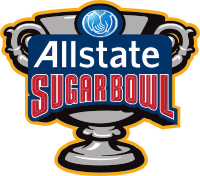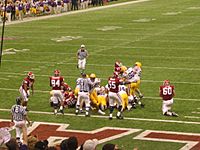Sugar Bowl facts for kids
Quick facts for kids Sugar Bowl |
|
|---|---|
| Allstate Sugar Bowl | |

Allstate Sugar Bowl logo
|
|
| Stadium | Mercedes-Benz Superdome |
| Location | New Orleans, Louisiana |
| Previous stadiums | Tulane Stadium (1934–1974) Georgia Dome (2006) |
| Previous locations | Atlanta, Georgia (2006) |
| Operated | 1935–present |
| Conference tie-ins | SEC (unofficial 1935–1975, official 1976–present) Big 12 (2015–present) |
| Payout | US$17 million per team (As of 2014[update]) |
| Sponsors | |
| Former names | |
|
Sugar Bowl (1935–1987)
USF&G Sugar Bowl (1988–1995) Nokia Sugar Bowl (1996–2006) |
|
| 2018 season matchup | |
| Georgia vs. Texas (Texas 28–21) | |
| 2019 season matchup | |
| Baylor vs. Georgia (Georgia 26–14) | |
The Sugar Bowl is an annual American college football bowl game played in New Orleans, Louisiana. It has been played annually since January 1, 1935, and celebrated its 75th anniversary on January 2, 2009. The Sugar Bowl, along with the Orange Bowl and Sun Bowl, are the second-oldest bowl games in the country, behind the Rose Bowl Game.
The Sugar Bowl was originally played at Tulane Stadium before moving to the Superdome in 1975. When the Superdome and the rest of the city suffered damage due to both the winds from and the flooding in the aftermath of Hurricane Katrina in 2005, the Sugar Bowl was temporarily moved to the Georgia Dome in Atlanta in 2006. Since 2007, the game has been sponsored by Allstate and officially known as the Allstate Sugar Bowl. Previous sponsors include Nokia (1996–2006) and USF&G Financial Services (1988–1995).
The Sugar Bowl has had a longstanding—albeit not exclusive—relationship with the Southeastern Conference (SEC) (which once had a member institution based in New Orleans, Tulane University; another Louisiana school, Louisiana State University (LSU) in Baton Rouge, is still in the SEC today). Indeed, the Sugar Bowl did not feature an SEC team only four times in its first 60 editions, and an SEC team played in the game in every year but one from 1950 to 1995. The SEC's opponent varied from year to year, but prior to the advent of the Bowl Championship Series, it was often the runner-up of the Big Eight, SWC, or a major independent.
The Sugar Bowl-SEC relationship has been altered over the past twenty years due to conference realignments and the emergence of a series of coalitions and alliances intending to produce an undisputed national champion in college football, but the ties between the Sugar Bowl and the SEC have persisted and have recently been strengthened. Since 2015, the Sugar Bowl, along with the Rose, Orange, Cotton, Peach, and Fiesta bowls, is one of the "New Year's Six" bowls in rotation for the College Football Playoff. It hosted a playoff semifinal following the 2014 and 2017 seasons, and will next host one following the 2020 season. In other years, it will feature the best available teams from SEC and the Big 12 conferences, an arrangement nearly identical with the relationship between the Rose Bowl and the champions of the Big Ten and Pac-12.
As a member of the Bowl Championship Series, the Sugar Bowl hosted the BCS National Championship Game twice 2000 and 2004, as the national championship rotated between the bowls themselves until 2006 (when the national championship game became a standalone event separate from the four BCS bowls, but was still rotated among the venues and organizers of the bowls).
The payout for the 2006 game was $14–17 million per participating team. According to Sports Illustrated, the 2007 salary for Sugar Bowl CEO Paul Hoolahan was $607,500.
Related pages
Images for kids
See also
 In Spanish: Sugar Bowl para niños
In Spanish: Sugar Bowl para niños




